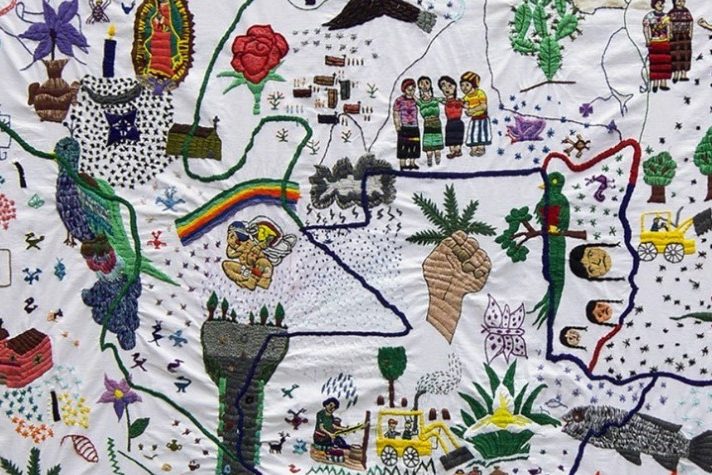Leonardo Figueroa Helland on Indigenous Ecologies
Leonardo Figueroa Helland, Associate Professor of Environmental Policy and Sustainability Management at the Milano School of Policy, Management, and Environment works at the intersection of diverse critical paradigms to study how indigenous knowledges combine with various transformative approaches to address environmental challenges, climate crises, and social injustices.

Prof. Figueroa Helland’s research triangulates political ecology, global studies, complex ecologism, world-systems ecology, ecofeminism, and intersectionality with indigenous and decolonial studies to articulate systemic alternatives that embody social, environmental, climate, and global justice. His writings address themes like global environmental politics and policy, indigeneity and decolonization, coloniality and ecological imperialism, gendered economies and socioecological reproduction, posthumanism and biocultural diversity, agroecology and sustainable food systems, social movements and prefigurative politics, energy geopolitics and energy.
Prof. Figueroa Helland sat down with the Milano school’s Environmental Policy and Sustainability Management division, for a Q&A:
Q: How do you explain the Anthropocene to those that aren’t familiar with the term?
A: The Anthropocene, a concept developed by the International Geosphere Biosphere Program, refers to a geological epoch in which human civilization is overwhelming the forces of the rest of nature and becoming the main driver of rapid—and largely destabilizing—changes in the Earth System. The arrival of the Anthropocene brings to an end the Holocene: an epoch spanning the last 11,700 years during which exceptionally stable climatic conditions enabled the rise of complex human civilizations based on, for instance, organized agriculture. In contrast, the Anthropocene signals an epoch where the largely destructive impacts of human civilization on the rest of nature is tipping the Earth System into a period of unpredictable and potentially catastrophic instability that could irreversibly imperil the continuation of human and non-human life. Two of the crucial markers of the Anthropocene are human driven climate change and human driven species extinctions. In relation to climate change, levels of greenhouse gases like carbon dioxide and methane, which lead to the warming of the atmosphere, are significantly higher than at any time in nearly a million years, and are rising much faster than in any previous warming period. Concerning biodiversity loss, species are now going extinct at a rate about 1,000 times greater than in preindustrial times. If habitat loss and overexploitation continue at this rate, 75% of species could die out in the next few centuries. Human civilization may thus become the cause of Earth’s sixth mass extinction event, equivalent to the extinction of the dinosaurs, 65 million years ago. Research has shown that the dominant way of life based on constantly expanding economic growth on a finite planet has already breached four of nine “planetary boundaries” (Stockholm Resilience Center), including climate change and biodiversity loss, and this is tipping the Earth System out of the relatively stable Holocene conditions.
There are several theses on the origins of the Anthropocene. Some argue it began with the rise of agricultural civilizations about 10,000 years ago while others underline how the emergence of patriarchal hierarchies which led to the subordination of both nature and women eventually produced an “Androcene” (an epoch dominated my “Man”), starting 6,000 years ago. Others still, emphasize how the colonization of the world by European empires starting over five centuries ago enabled the rise of an extractivist, resource intensive Eurocentric world-capitalist system ushering in the “Eurocene” and “Capitalocene”, an epoch dominated by European or Western capitalist civilization and centered in the Global North. Others cite the industrial revolution and the second wave of imperialism as the starting point in the 1700s. Finally, some point at the “great acceleration”, when after 1945 the Western model of modernization, industrialization and consumerism became an international project, eventually globalized during the neoliberal period (post-1970s).
All of these drivers have a role in understanding the current Anthropocene and its associated crises. Moreover, these debates are relevant because they highlight the fact that not all humans are equally responsible for the dominance of an anthropocentric (human-centric) civilization that has come to overwhelm the planet and the forces of the rest of nature. Suffice it to underline, as the Ecological Footprint Network points out, that if everybody in the world had an ecological footprint equal to the average US or Canadian resident we would need between three and five Earths to regenerate humanity’s annual demand on nature. Furthermore, if everybody had the ecological footprint of the average EU resident we would need the equivalent of between 2.5 and 3.5 Earths. In fact, 20% of the world’s privileged consumer population consumes 80% of the planet’s resources and owns 95% of the planet’s wealth, with males and populations of European ancestry overrepresented in this top 20%. This population is concentrated in the Global North and increasingly also among the elites and upper-middle classes of the Global South aspiring to the consumerist lifestyle of the Global North.
Finally, the Global North nations have consumed more than three times their share of the atmosphere (in terms of the amount of emissions that we can safely put into the atmosphere) while the poorest 10 percent of the world’s population has contributed less than 1 percent of CO2 emissions. Among these, the indigenous populations of the world are among the least responsible for ecological degradation and climate change, and often those who suffer the most from its consequences, and hence the relevance of concepts like environmental/climate (in)justice and ecological/climate debt.
Read his complete interview with the Milano School of Policy, Management, and Environment on the Milano School blog.
Source: Milano School

